Using XML Gateway Inbound and Outbound Interfaces
Overview
Oracle E-Business Suite Integrated SOA Gateway provides a communication infrastructure between Oracle E-Business Suite and web consumers. Inbound and outbound XML data is exchanged between the consumers and Oracle E-Business Suite through Oracle XML Gateway.
Oracle XML Gateway provides a common, standards-based approach for XML integration. XML is key to integration solutions, as it standardizes the way in which data is searched, exchanged, and presented thereby enabling interoperability throughout the supply chain.
Oracle XML Gateway provides a set of services that can be easily integrated with Oracle E-Business Suite to support XML messaging. It uses the message propagation feature of Oracle Advanced Queuing to integrate with Oracle Transport Agent to deliver outbound XML messages and receive inbound XML messages or transactions from business partners.
To enable bidirectional integration with Oracle E-Business Suite and consumers, Oracle E-Business Suite Integrated SOA Gateway supports XML Gateway Map interface type through the following approaches:
-
For an inbound XML Gateway Map interface, once a web service of an inbound XML Gateway interface is deployed, the deployed service represented in WSDL can be used in creating a SOA composite application with BPEL process to insert inbound data into Oracle E-Business Suite.
-
For an outbound XML Gateway Map interface, since an outbound message is first enqueued to the ECX_OUTBOUND queue, Oracle E-Business Suite Integrated SOA Gateway supports it through subscription model. This can be done by dequeuing the message to retrieve outbound data from Oracle E-Business Suite. The retrieved data can then be passed to trading partners or consumers who subscribed to the message.
To better understand how to use a deployed web service of an inbound XML Gateway interface as well as understand how the subscription model works for an outbound XML Gateway, the following topics are discussed in this chapter:
For the examples described in the following sections, Oracle JDeveloper 11g (11.1.1.6.0) is used as a design-time tool to create a SOA composite application with BPEL process and Oracle SOA Suite 11g (11.1.1.6.0) is used for the process deployment.
Note: While using Oracle JDeveloper with other Oracle Fusion Middleware components (such as Oracle SOA Suite), to enable SOA technologies, you need to manually download Oracle SOA Suite Composite Editor, a JDeveloper's extension for SOA technologies. For more information on installing additional Oracle Fusion Middleware design time components, see the Oracle Fusion Middleware Installation Guide for Oracle JDeveloper.
Using XML Gateway Inbound Services
This section includes the following topics:
Using XML Gateway Inbound Services at Design Time
SOA Composite Application with BPEL Process Scenario
Consider the XML Gateway Inbound Process PO XML Transaction as an example to explain the SOA Composite application with BPEL process creation. In this example, the XML Gateway inbound message map is exposed as a web service through PROCESS_PO_007 inbound map. It allows sales order data including header and line items to be inserted into Order Management system while an associated purchase order is created.
When a purchase order is sent by a trading partner, the purchase order data is used as input to the BPEL process along with ECX Header properties such as MESSAGE_TYPE, MESSAGE_STANDARD, TRANSACTION_TYPE, TRANSACTION_SUBTYPE, PARTY_SITE_ID, and DOCUMENT_NUMBER. The BPEL process then pushes this purchase order in the ECX_INBOUND queue. Agent Listeners running on the ECX_INBOUND queue would enable further processing by the Execution Engine. Oracle XML Gateway picks up this XML message, does trading partner validation, and inserts order data to Order Management Application.
When the SOA Composite application with BPEL process has been successfully invoked after deployment, the same order information will be inserted into the Order Management table once a purchase order is created.
Prerequisites to Configure a SOA Composite Application with BPEL Process Using an XML Gateway Inbound Service
Before performing the design-time tasks for XML Gateway Inbound services, ensure the following tasks are in place:
-
An integration administrator or an integration developer needs to generate a web service first. The administrator will then deploy the generated service to an Oracle SOA Suite WebLogic managed server.
-
An integration developer needs to locate and record the deployed WSDL URL for the inbound message map exposed as a web service.
-
XML Gateway header variables need to be populated for XML transaction.
-
A trading partner should be available for receiving the XML documents.
-
ECX Inbound Agent Listener and ECX Transaction Agent Listener must be up and running.
Deploying an XML Gateway Inbound Web Service Composite
Once a web service for the selected XML Gateway inbound map has been successfully created, the integration administrator must deploy the service from Oracle Integration Repository to an Oracle SOA Suite WebLogic managed server.
For example, the following steps must be performed first before the integration developer can create a SOA Composite application with BPEL process by using the deployed WSDL:
-
To generate a web service, the integration administrator or the integration developer locates the interface definition first (such as an XML Gateway inbound interface
INBOUND:Process Purchase Order XML Transaction (ONT:POI)) and clicks Generate in the interface details page.Once the service has been successfully generated, the Web Service Status field changed from 'Not Generated' to 'Generated' in the Web Service region.
For detailed instructions on how to generate a web service, see Generating SOAP Web Services, Oracle E-Business Suite Integrated SOA Gateway Implementation Guide.
-
To deploy a generated web service, the integration administrator selects one authentication type before clicking Deploy. The deployed service in Oracle SOA Suite is an active service and is ready to accept new SOAP requests.
Once the service has been successfully deployed, the selected authentication type will be displayed along with 'Deployed' with 'Active' state in the Web Service Status field. For more information on securing web services with the authentication type, see Managing Web Service Security, Oracle E-Business Suite Integrated SOA Gateway Implementation Guide.
For information on how to deploy a web service, see Deploying and Undeploying SOAP Web Services, Oracle E-Business Suite Integrated SOA Gateway Implementation Guide.
Searching and Recording a WSDL URL
The integration developer needs to locate and record the deployed web service WSDL URL for the inbound message map.
This WSDL information will be used later in creating a partner link for the inbound map exposed as a web service during the BPEL process creation at design time.
For information on how to search for an interface and review the interface details, see Searching and Viewing Integration Interfaces.
Populating XML Gateway Header Variables
Certain variables in the BPEL PM must be populated in order to provide XML Gateway header information for Oracle E-Business Suite. MESSAGE_TYPE, MESSAGE_STANDARD, TRANSACTION_TYPE, TRANSACTION_SUBTYPE, DOCUMENT_NUMBER and PARTY_SITE_ID are the mandatory header variables that need to be populated in order for the XML transaction to complete successfully.
Refer to Adding an Assign Activity.
Setting Up a Trading Partner for Receiving XML Documents
Use the following steps to set up a trading partner:
-
Log in to Oracle E-Business Suite as a user who has the XML Gateway responsibility.
-
Click the Define Trading Partners link from the Navigator.
-
The Trading Partner Setup form is displayed. Search an existing trading partner by selecting View > Query by Example > Enter and enter the following information:
-
Trading Partner Type: Customer
-
Trading Partner Name: Example Inc.
-
Trading Partner Site: 401 Island Parkway Redwood Shores, CA 94065
Run the query by selecting View > Query by Example > Enter to locate the trading partner "Example Inc." along with existing transactions.
For information on setting up a trading partner, see Trading Partner Setup, Oracle XML Gateway User's Guide.
Trading Partner Setup Form

Enter the following trading partner details:
-
Transaction Type: ONT
-
Transaction SubType: POI
-
Standard Code: OAG
-
External Transaction Type: PO
-
External Transaction SubType: PROCESS
-
Direction: IN
-
Map: ONT_3A4R_OAG72_IN
-
Source Trading Partner Location Code: Example-01
-
-
Save your entry.
Ensuring Agent Listeners Are Up and Running
Make sure that agent listeners on the ECX_INBOUND and ECX_TRANSACTION queues are up and running. Use the following steps to configure these listeners in Oracle E-Business Suite:
-
Log in to Oracle E-Business Suite as a user who has the Workflow Administrator responsibility.
-
Click the Workflow Administrator Web Applications link from the Navigator.
-
Click the Workflow Manager link under Oracle Applications Manager.
-
Click the status icon next to Agent Listeners.
-
Configure and schedule the ECX Inbound Agent Listener and the ECX Transaction Agent Listener. Select the listeners, and select Start from the Actions box. Click Go if they are not up and running.
SOA Composite Application with BPEL Process Creation Flow
Based on the XML Gateway Inbound Process PO XML Transaction business scenario, the following design-time tasks are included in this chapter:
-
Create a New SOA Composite Application with BPEL Process
Use this step to create a new SOA Composite application with BPEL process called
XMLGatewayInbound.bpelusing an Synchronous BPEL Process template. This automatically creates two dummy activities - Receive and Reply - to receive input from a trading partner and to reply output of the BPEL process to the request application. -
Use this step to create a partner link to allow the inbound message to be inserted to Oracle E-Business Suite.
-
Add a Partner Link for File Adapter
Use this step to add a partner link for File Adapter in order to pick up an XML file received from the trading partner to get the XML message.
-
Use this step to add two Invoke activities in order to:
-
Get the XML message details that is received from the Receive activity.
-
Enqueue the purchase order information to the ECX_INBOUND queue.
-
-
Use this step to create two Assign activities in order to:
-
Pass XML message obtained from the first Invoke activity to the second Invoke activity.
-
Pass ECX header variables to the second Invoke activity as input variables.
-
For general information and how to create SOA composite applications using BPEL process service component, see the Oracle Fusion Middleware Developer's Guide for Oracle SOA Suite for details.
Creating a New SOA Composite Application with BPEL Process
Use this step to create a new SOA composite application that will contain various BPEL process activities.
To create a new SOA composite application with BPEL process:
-
Open Oracle JDeveloper.
-
Click New Application in the Application Navigator.
The "Create SOA Application - Name your application" page is displayed.
The Create SOA Application - Name your application Page
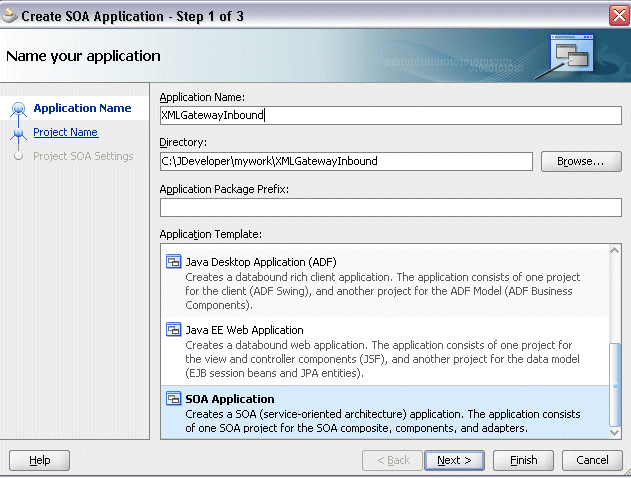
-
Enter an appropriate name for the application in the Application Name field and select SOA Application from the Application Template list.
Click Next. The "Create SOA Application - Name your project" page is displayed.
The Create SOA Application - Name your project Page

-
Enter an appropriate name for the project in the Project Name field, for example,
XMLGatewayInbound. -
In the Project Technologies tab, select 'Web Services' and ensure that SOA is selected from the Available technology list to the Selected technology list.
Click Next. The "Create SOA Application - Configure SOA settings" page is displayed.
-
Select Composite With BPEL Process from the Composite Template list, and then click Finish. You have created a new application, and a SOA project. This automatically creates a SOA composite.
The Create BPEL Process page is displayed.
The Create BPEL Process Page
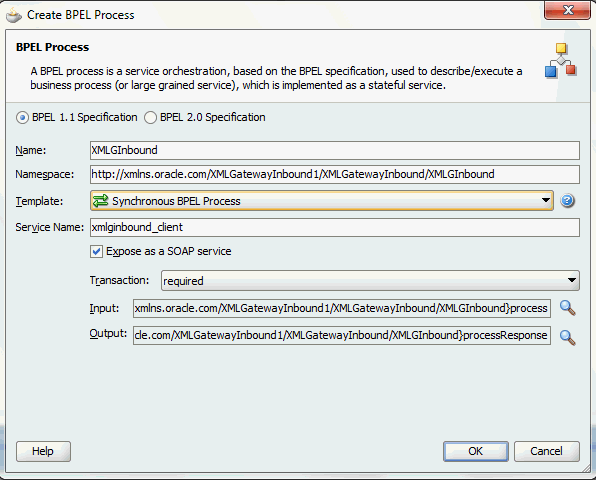
-
Leave the default BPEL 1.1 Specification selection unchanged. This creates a BPEL project that supports the BPEL 1.1 specification.
Enter an appropriate name for the BPEL process in the Name field, for example,
XMLGInbound.Select Synchronous BPEL Process in the Template field.
Select required from the Transaction drop-down list. Click OK.
A synchronous BPEL process is created with the Receive and Reply activities. The required source files including bpel and wsdl, using the name you specified (for example,
XMLGInbound.bpelandXMLGInbound.wsdl) andcomposite.xmlare also generated. -
Navigate to SOA Content > Business Rules and click the
composite.xmlto view the composite diagram.Composite Diagram

Double click on the
XMLGInboundcomponent to open the BPEL process.
Creating a Partner Link
Use this step to create a Partner Link called ONT__POI to insert sales order data to Oracle E-Business Suite.
To create a partner link to insert sales data to Oracle E-Business Suite:
-
In Oracle JDeveloper, place your mouse in the right side of the Partner Links area and right click to select Create Partner Link... from the pull-down menu. Alternatively, you can drag and drop Partner Link from the BPEL Constructs list into the right Partner Link swim lane of the process diagram.
The Create Partner Link window appears.
-
Copy the WSDL URL corresponding to the XML Gateway inbound map
INBOUND:Process Purchase Order XML Transaction (ONT:POI)that you recorded earlier from the Integration Repository and paste it in the WSDL File field.Press the [Tab] key.
-
A Partner Link Type message dialog box appears asking whether you want the system to create a new WSDL file that will by default create partner link types for you.
Click Yes to have the Partner Name value populated automatically. You can manually enter the partner link name as ONT__POI.
Create Partner Link Dialog
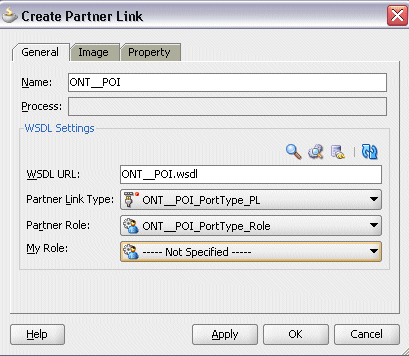
Select the Partner Link Type and Partner Role fields from the drop-down lists.
Click Apply and OK.
The partner link is created with the required WSDL settings, and is represented in the BPEL project by a new icon in the border area of the process diagram.
Partner Link is added to the Partner Links section in the BPEL process diagram.
Double click the ONT__POIWrapper.wsdl and click the Source tab to view the source WSDL description for the partner link you just created. Replace the reference WSDL with the deployed service end point WSDL. Save your changes by selecting File > Save All.
Adding Partner Links for File Adapter
Use this step to configure a BPEL process by adding a partner link for File Adapter to get the XML Message.
To add the Partner Link for File Adapter to get the XML Message:
-
In Oracle JDeveloper, drag and drop the File Adapter service from the BPEL Services into the right Partner Link swim lane of the process diagram. The Adapter Configuration wizard welcome page appears.
-
Click Next. The Service Name dialog box appears.
-
Enter a name for the file adapter service, such as
GetXMLMsg. You can add an optional description of the service. -
Click Next. The Adapter Interface dialog box appears.
-
Select the Define from operation and schema (specified later) radio button and click Next. The Operation dialog box appears.
Operation Dialog

-
Specify the operation type, for example Synchronous Read File. This automatically populates the Operation Name field.
Click Next to access the File Directories dialog box.
File Directories Dialog

-
Select the Physical Path radio button and enter the input payload file directory information. For example, enter
/usr/tmp/.Note: To be able to locate the file from the physical directory that you specified here, you must first place the input payload file (such as
order_data_xmlg.xml) to the specified directory.Click Next to open the File Name dialog box.
-
Enter the name of the file for the synchronous read file operation. For example, enter
order_data_xmlg.xml. Click Next. The Messages dialog box appears.Messages Dialog

-
Select Browse for schema file in front of the URL field.
The Type Chooser window is displayed.
Click the Import Schema Files button on the top right corner of the Type Chooser window. This opens the Import Schema File pop-up window.
Enter the schema location for the service, such as
http://<soa_suite_hostname>:<port>/soa-infra/services/default/<jndi_name>_XMLGATEWAY_ONT__POI/ONT__POI_Service?XSD=xsd/PROCESS_PO_007.xsdSchema location for your service can be found from the service WSDL URL (for example,
http://<soa_suite_hostname>:<port>/soa-infra/services/default/<jndi_name>_XMLGATEWAY_ONT__POI/ONT__POI_Service?wsdl).Select the Copy to Project checkbox and click OK.
-
The Localize Files window appears. Ensure the Maintain original directory structure for imported files checkbox is selected and click OK.
The Imported Schema folder is automatically added to the Type Chooser window.
-
Expand the imported schema folder and select PROCESS_PO_007 from the
PROCESS_PO_007.xsd. Click OK. The selectedPROCESS_PO_007.xsdis displayed as URL and the PROCESS_PO_007 element is selected as Schema Element.Click Next and then Finish. The wizard generates the WSDL file corresponding to the partner link. The main Create Partner Link dialog box appears, specifying the new WSDL file
GetXMLMsg.wsdl.Click Apply and then OK to complete the configuration and create the partner link with the required WSDL settings for the File Adapter service.
The
GetXMLMsgPartner Link appears in the BPEL process diagram.
Under applications window, navigate to file GetXMLMsg_file.jca. Set value of property "DeleteFile" to "false".
Adding Invoke Activities
This step is to configure three Invoke activities:
-
To get the XML message details that is received from the Receive activity by invoking the
GetXMLMsgpartner link in an XML file. -
To enqueue the purchase order information to the ECX_INBOUND queue by invoking
ONT_POIpartner link in an XML file.
To add the first Invoke activity for a partner link to get XML message:
-
In Oracle JDeveloper, expand the BPEL Constructs from the Component Palette. Drag and drop the Invoke activity into the center swim lane of the process diagram, between the receiveInput and replyOutput activities.
-
Link the Invoke activity to the
GetXMLMsgservice. The Edit Invoke dialog box appears. -
Enter a name for the Invoke activity (such as 'Invoke_Msg') and then click the Create icon next to the Input Variable field to create a new variable. The Create Variable dialog box appears.
-
Enter an input variable name. You can also accept the default name. Select Global Variable and click OK.
-
Click the Create icon next to the Output Variable field to create a new variable. The Create Variable dialog box appears.
-
Enter an input variable name. You can also accept the default name. Select Global Variable and click OK.
-
Click Apply and then OK in the Edit Invoke dialog box to finish configuring the Invoke activity.
The first Invoke activity appears in the process diagram.
To add the second Invoke activity for a partner link to enqueue PO information:
-
In Oracle JDeveloper, expand the BPEL Constructs from the Component Palette. Drag and drop the second Invoke activity into the center swim lane of the process diagram, after the first Invoke activity and the reployOutput activity.
-
Link the Invoke activity to the
ONT_POIservice. The Edit Invoke dialog box appears. -
Enter a name for the Invoke activity and then click the Create icon next to the Input Variable field to create a new variable. The Create Variable dialog box appears.
-
Enter an input variable name. You can also accept the default name. Select Global Variable and click OK.
-
Click Apply and then OK in the Edit Invoke dialog box to finish configuring the Invoke activity.
-
The process diagram appears.
Adding Assign Activities
This step is to configure two Assign activities:
-
To pass XML message as an input to the Invoke activity for enqueuing message.
-
To pass XML Gateway header variables as input variables to the Invoke activity in order to provide context information for Oracle E-Business Suite.
To add the first Assign activity to pass XML message as input to the Invoke activity:
-
In Oracle JDeveloper, expand the BPEL Constructs from the Component Palette. Drag and drop the Assign activity into the center swim lane of the process diagram between the two Invoke activities you just created earlier.
-
Double-click the Assign activity to access the Edit Assign dialog box.
-
Click the General tab to enter the name for the Assign activity, such as 'SetOrderXML'.
-
Select the Copy Rules tab and expand the source and target trees:
-
In the From navigation tree, navigate to Variables > Process > Variables > Invoke_Msg_SynchRead_OutputVariable and select Process_PO_007.
-
In the To navigation tree, navigate to Variables > Process > Variables > Invoke_ONT__POI_InputVariable and select body.
Drag the source node (Process_PO_007) to connect to the target node (body) that you just identified. This creates a line that connects the source and target nodes. The copy rule is displayed in the From and To sections at the bottom of the Edit Assign dialog box.
-
-
Click Apply and then OK to complete the configuration of the Assign activity.
To add the second Assign activity to pass XML Gateway header variables to the Invoke activity:
-
In Oracle JDeveloper, expand the BPEL Constructs from the Component Palette. Drag and drop the Assign activity into the center swim lane of the process diagram between the first Assign and the second Invoke activities you just created earlier.
Add the second Assign activity by dragging and dropping the Assign activity into the center swim lane of the process diagram between the
SetOrderXMLAssign activity and the second Invoke activity. -
Repeat Step 2 to Step 3 described in creating the first Assign activity to add the second Assign activity called 'SetECXHeader'.
-
Select the Copy Rules tab and expand the source and target trees:
-
Click the Expression icon to invoke the Expression Builder dialog.
Enter 'XML' in the Expression box. Click OK. The Expression icon with the expression value ('XML') appears in the center of the Edit Assign dialog, between the From and To navigation tree nodes.
-
In the To navigation tree, navigate to Variables > Process > Variables > Invoke_ONT__POI_InputVariable > header > ns1:SOAHeader > ns4:ECXMSG and select MESSAGE_TYPE.
The XPath field should contain your selected entry.
Drag the Expression icon to connect to the target node (MESSAGE_TYPE) that you just identified. This creates a line that connects the source and target nodes. The copy rule is displayed in the From and To sections at the bottom of the Edit Assign dialog box.
-
-
Use the same mechanism described in step 3 to assign values to the following parameters:
-
MESSAGE_STANDARD: 'OAG'
-
TRANSACTION_TYPE: 'PO'
-
TRANSACTION_SUBTYPE: 'PROCESS'
-
DOCUMENT_NUMBER: 'PO-4466-5'
-
PARTY_SIDE_ID: 'Example-01'
-
-
Click Apply and OK to complete the configuration of the Assign activity.
Configuring Web Service Policies
Use the following steps to add security policies at design time:
-
Navigate to SOA Content > Business Rules > composite.xml. Right click on the
ONT__POIservice and select "Configure WS Policies" from the drop-down list. -
The Configure SOA WS Policies dialog appears.
In the Security section, click the Add icon (+). The Select Server Security Policies dialog appears.
Select Server Security Policies Dialog
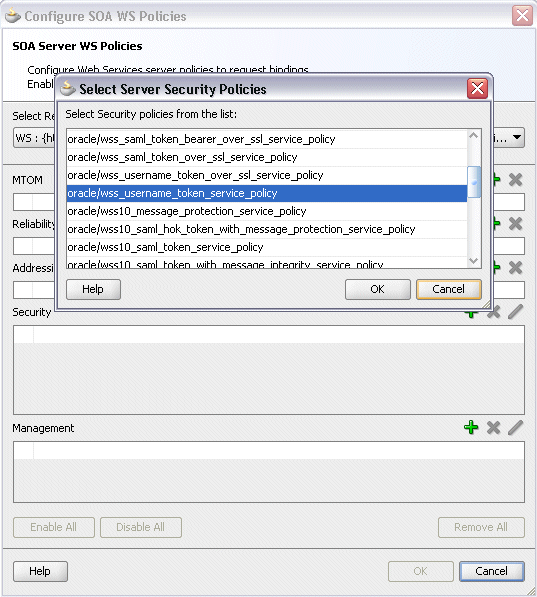
Select 'oracle/wss_username_token_service_policy' and click OK.
The attached security policy is shown in the Security section.
A lock icon appears in the
ONT__POIservice of thecomposite.xmlindicating that a security policy has been successfully attached. -
From the navigation menu, select View > Property Inspector to display the Property Inspector window for
ONT__POIservice component.In the Properties section, click the Add icon (+) for binding properties. The Create Property dialog appears.
Enter '
oracle.webservices.auth.username' in the Name field and enter 'operations' as the value.Create Property Dialog for Entering Username Property

Click OK.
-
Use the same approach by clicking the Add icon (+) again in the Properties section for binding properties. Enter '
oracle.webservices.auth.password' in the Name field. Enter the associated password for user 'operations' in the Value field.Create Property Dialog for Entering Password Property
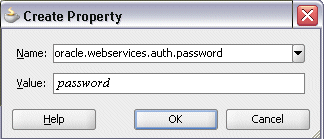
Click OK.
Both selected property names and values appear in the Properties section.
Click the Source tab of
composite.xmland notice that theoracle.webservices.auth.usernameandoracle.webservices.auth.passwordproperty names and the associated values are added to theONT__POIreference.Verification of the Property Information in Composite.xml

Deploying and Testing the SOA Composite with BPEL Process at Runtime
To invoke the synchronous XML Gateway inbound map (PROCESS_PO_007) service from the BPEL client contained in the SOA composite, the SOA composite needs to be deployed to the Oracle WebLogic managed server. This can be achieved using Oracle JDeveloper. Once the composite is deployed, it can be tested from the Oracle Enterprise Manager Fusion Middleware Control Console.
Prerequisites
Before deploying the SOA composite with BPEL process using Oracle JDeveloper, you must have established the connectivity between the design-time environment and the runtime server. For information on how to configure the necessary server connection, see Configuring Server Connection.
Note: If a local instance of the WebLogic Server is used, start the WebLogic Server by selecting Run > Start Server Instance from Oracle JDeveloper. Once the WebLogic Admin Server "DefaultServer" instance is successfully started, the <Server started in Running mode> and DefaultServer started message in the Running:DefaultServer and Messages logs should appear.
For the payload information, see Sample Payload for Inbound Process Purchase Order XML Transaction.
Perform the following runtime tasks:
Deploying the SOA Composite with BPEL Process
You must deploy the SOA composite with BPEL process (XMLGatewayInbound.bpel) that you created earlier before you can run it.
Note: Before deploying the with SOA composite for XML Gateway Inbound service, you should:
-
Load the
order_data_xmlg.xmlfile into the specified directory '/usr/tmp/' folder of SOA Suite server. -
Edit the input file
order_data_xmlg.xmlby entering values for <REFERENCEID> and <POID> such as 'PO-4466-5'.
To deploy the SOA Composite with BPEL process:
-
In the Applications Navigator of JDeveloper, select the XMLGInbound project.
-
Right-click the project and select Deploy > [project name] > [serverConnection] from the menu.
For example, you can select Deploy > XMLGInbound > SOAServer to deploy the process if you have the connection set up appropriately.
Note: If this is the first time to set up the server connection, then the Deployment Action dialog appears. Select 'Deploy to Application Server' and click Next.
Deployment Action Dialog
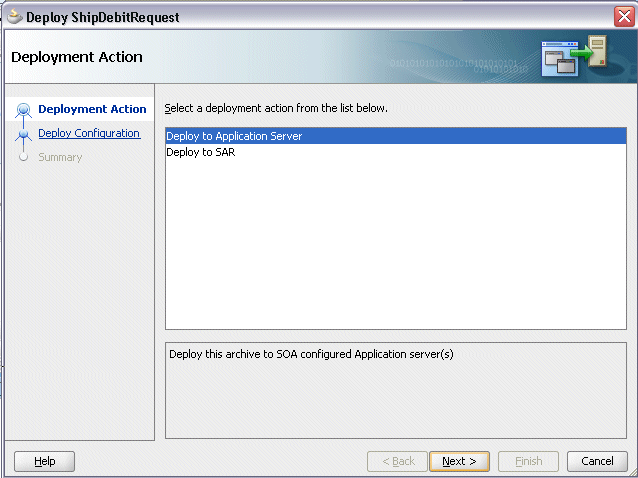
In the Deploy Configuration dialog, ensure the following information is selected before clicking Next to add a new application server:
-
New Revision ID: 1.0
-
Mark composite revision as default: Select this checkbox.
-
Overwrite any existing composites with the same revision ID: Select this checkbox.
The steps to create a new Oracle WebLogic Server connection from JDeveloper are covered in Configuring Server Connection.
-
-
In the Select Server dialog, select 'soa-server1' that you have established the server connection earlier. Click Next.
-
In the SOA Servers dialog, accept the default target SOA Server ('soa-server1') selection.
Click Next and Finish.
-
If you are deploying the composite for the first time from your Oracle JDeveloper session, the Authorization Request window appears. Enter username and password information specified during Oracle SOA Suite installation. Click OK.
-
Deployment processing starts. Monitor deployment process and check for successful compilation in the SOA - Log window.
Verify that the deployment is successful in the Deployment - Log window.
Deployment - Log Window

Testing the SOA Composite Application with BPEL Process
Once the BPEL process contained in the SOA composite application has been successfully deployed, you can manage and monitor the process from Oracle Enterprise Manager Fusion Middleware Control Console. You can also test the process and the integration interface by manually initiating the process.
For more information about Oracle SOA Suite, see the Oracle Fusion Middleware Administrator's Guide for Oracle SOA Suite.
To test the SOA composite application with BPEL process:
-
Navigate to Oracle Enterprise Manager Fusion Middleware Control Console (
http://<hostname>:<port>/em). The login page appears. -
Enter the user name and password information specified during the installation, and then click Login to log in to a farm. The composite (XMLGInbound) you deployed is displayed in the Applications Navigation tree.
You may need to select an appropriate target instance farm if there are multiple target Oracle Enterprise Manager Fusion Middleware Control Console farms.
-
From the Farm navigation pane, expand the
SOA >soa-infranode in the tree to navigate through the SOA Infrastructure home page and menu to access your deployed SOA composite applications running onsoa-inframanaged server.Click the XMLGInbound [1.0] link.
-
Click the Policies tab and notice that the 'oracle/wss_username_token_service_policy' policy you attached to the
ONT__POIservice binding earlier at the design time is now displayed here. -
In the XMLGInbound [1.0] home page, click Test.
-
The Test Web Service page for initiating an instance appears.
Note: If the WS-Security credentials are not entered at design time, you can enter the credentials at runtime by selecting the WSS Username Token option in the Security section at the top of the Request tab. Enter 'operations' in the Username field and the associated password for user 'operations' in the Password field.
Test Web Service Page: Request Tab

-
Enter the input string (such as 'test') required by the process and click Test Web Service to initiate the process.
The test results appear in the Response tab upon completion.
-
Click the Instances tab. The SOA composite application instance ID, name, conversation ID, most recent known state of each instance since the last data refresh of the page are displayed.
-
Click your BPEL service component instance link (such as XMLGInbound) to display the Instances page where you can view the process details of the BPEL activities in the Audit Trail tab.
Click the Flow tab to check the BPEL process flow diagram. Click an activity of the process diagram to view the activity details and flow of the payload through the process.
Verifying Records in Oracle E-Business Suite
Once the BPEL process has been successfully initiated and completed, you can validate the transaction in Oracle E-Business Suite.
To Validate the Transaction in Oracle Transaction Monitor:
You can validate it from the Transaction Monitor. The Transaction Monitor is a tool for monitoring the status of inbound and outbound transactions originating from and going into Oracle E-Business Suite that have been processed by the XML Gateway and delivered or received by the Oracle Transport Agent. It shows a complete history and audit trail of these documents.
-
Log in to Oracle E-Business Suite as a user who has the Workflow Administrator Web Applications responsibility.
Select the Transaction Monitor link to open the search window to search for the order.
Transaction Monitor: Search Page
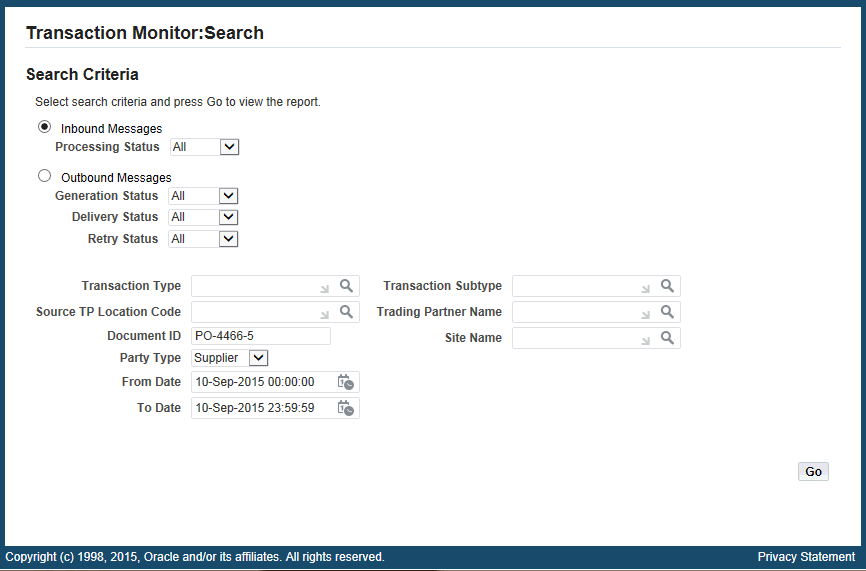
-
Clear From Date and To Date fields and enter 'PO-4466-5' in the Document ID field.
-
Select Customer as the Party Type. Click Go.
This retrieves XML inbound transaction 'PO-4466-5' in the Inbound Search Results region.
-
Confirm that the transaction 'PO-4466-5' has status 'SUCCESS'.
You can verify it by logging on to Oracle E-Business Suite with the Order Management Super User, Vision Operations (USA) responsibility. Select Orders, Returns: Import Orders > Corrections. The Find Orders window is displayed and select 'XML' from drop-down list in the Order Source field. The Corrections window is displayed with all the transactions with the XML order source.
Notice that 'PO-4466-5' is listed in the Orig_Sys_Document_Reference field.
Corrections Window to Verify the Transactions
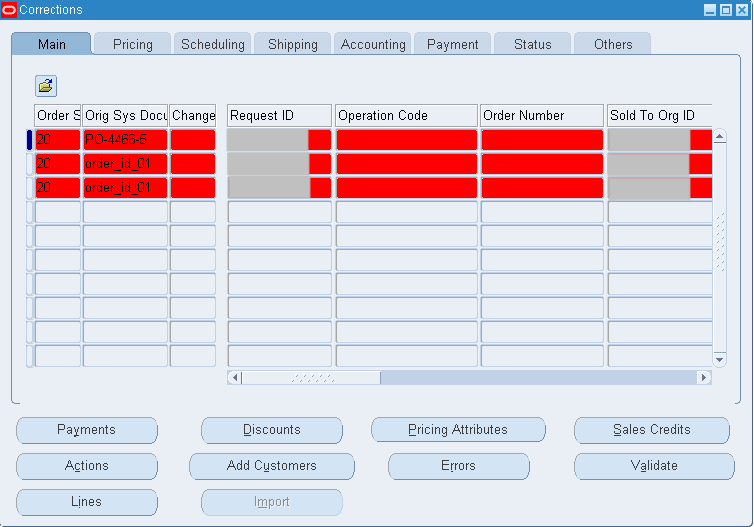
To Import the Order to Oracle Order Management:
-
Log in to the Forms-based Oracle E-Business Suite as a user who has the Order Management Super User, Vision Operations (USA) responsibility.
-
Select Orders, Returns : Import Orders > Order Import Request. The Order Import Request form is displayed along with the Parameters dialog.
Select 'PO-4466-5' from the Order Reference drop-down list.
Order Import Request Form and Parameters Dialog
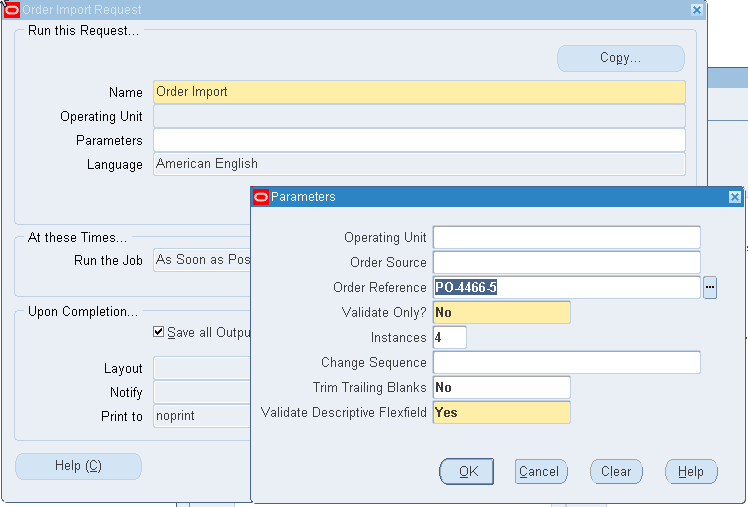
-
Click OK in the parameters dialog. The Order Import request name is populated automatically in the Import Request form.
-
Click Submit to submit the request. This displays a concurrent request number. Record the request number, but click No in the Decision dialog that you will not submit another request.
-
From the application menu, select View > Requests to open the Find Requests form.
-
Enter the request number you recorded earlier and click Find.
This would show the status of Order Import request. It should be success and the order should be created in Order Management application.
To Validate the Transaction in Oracle Order Management:
-
Log in to the Forms-based Oracle E-Business Suite as a user who has the Order Management, Super User responsibility.
-
Select Order Returns > Sales Order. The Sales Order form is displayed.
-
Search for an order by entering the order number in the Customer PO field (such as 'PO-4466-5'). The details of a newly created order appears.
Sales Orders Form
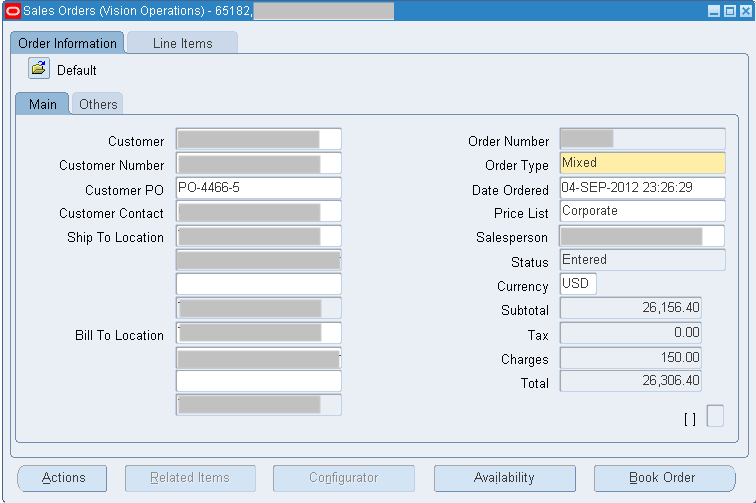
Using XML Gateway Outbound Through Subscription Model
This section includes the following topics:
Using XML Gateway Outbound Services at Design Time
For an outbound XML Gateway Map interface, since an outbound message is first enqueued to the ECX_OUTBOUND queue, Oracle BPEL PM listens to the ECX_OUTBOUND queue for the message with the same correlation Id.
Oracle E-Business Suite Integrated SOA Gateway supports it through subscription model by dequeuing the message in the ECX_OUTBOUND queue to retrieve outbound data from Oracle E-Business Suite. The retrieved data can be passed to trading partners or consumers who subscribed to the message.
SOA Composite Application with BPEL Process Scenario
Take XML Gateway outbound interface 'PO acknowledgement XML Transaction' as an example. The XML Gateway outbound interface is exposed as a web service through ECX_CBODO_OAG72_OUT outbound map.
When a purchase order is created and approved, on approval of the purchase order, a workflow will be triggered which creates the Purchase Order Acknowledgement flow and sends out the PO Acknowledgement as an XML file. The workflow delivers the Confirm BOD as the PO Acknowledgement to the ECX_OUTBOUND queue for delivery to the other system.
The correlation Id for this message is set to 'BPEL' and the Oracle BPEL PM listens to the ECX_OUTBOUND queue for the message with the correlation Id = 'BPEL'. 'Confirm BOD' as the PO Acknowledgement is written as an output XML file using File Adapter.
When the BPEL process has been successfully processed after deployment, the same order book reference ID (Customer PO) from the output XML file should be obtained once a purchase order is approved.
Prerequisites to Create a BPEL Process Using XML Gateway Outbound Messaging
You need to set up the correlation identifier in Oracle E-Business Suite. The correlation identifier enables you to label messages meant for a specific agent, in case there are multiple agents listening on the outbound queue. The agent listening for a particular correlation picks up the messages that match the correlation identifier for the agent.
To set up the correlation identifier:
-
Log in to Oracle E-Business Suite as a user who has the XML Gateway responsibility. The Navigator page appears.
-
Click the XML Gateway link.
-
Click the Define Lookup Values link under XML Gateway.
-
Search for
COMM_METHODin the Type field to see if it exists in the system.XML Gateway Lookups Form

-
Add a new record to the
COMM_METHODtype by enteringBPELfor the Code field and the Meaning field. Enter description information and save the record.Oracle XML Gateway puts the correlation of BPEL when enqueueing the message on the ECX_OUTBOUND queue.
In addition to having the correlation identifier set up correctly, you need to ensure the trading partner that you want to use has the Protocol Type field set to BPEL. For information on how to set up the trading partner with desired transactions, see Manually test the SOA Composite Application.
Trading Partner Setup Form
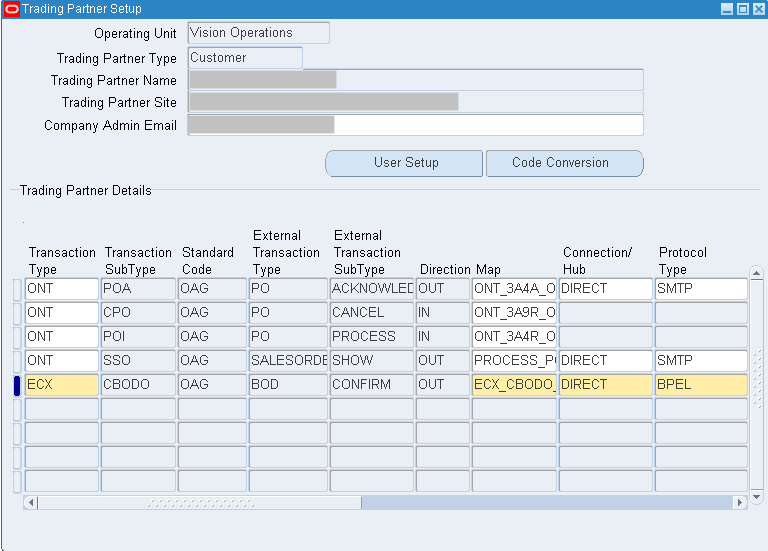
SOA Composite Application with BPEL Process Creation Flow
Based on the PO acknowledgement XML Transaction scenario, the following design-time tasks are discussed in this chapter:
-
Create a new SOA Composite Application with BPEL Process
Use this step to create a new SOA composite application with BPEL process called
XMLGOutbound.bpel. -
Create a Partner Link for AQ Adapter
Use this step to dequeue the event details from the ECX_OUTBOUND queue.
-
Use the Receive activity to take PO acknowledgement details as an input to the Assign activity.
-
Add a Partner Link for File Adapter
This is to write PO acknowledgement details in an XML file as an output file.
-
This is to write PO acknowledgement information to an XML file through invoking the partner link for File Adapter.
-
Use the Assign activity to take the output from the Receive activity and to provide input to the Invoke activity.
For general information and how to create SOA composite applications using BPEL process service component, see the Oracle Fusion Middleware Developer's Guide for Oracle SOA Suite for details.
Creating a New SOA Composite Application with BPEL Process
Use this step to create a new SOA composite application that will contain various BPEL process activities.
To create a new SOA composite application with BPEL process:
-
Open Oracle JDeveloper.
-
Click New Application in the Application Navigator. The "Create SOA Application - Name your application" page is displayed.
-
Enter an appropriate name for the application in the Application Name field and select SOA Application from the Application Template list.
Click Next. The "Create SOA Application - Name your project" page is displayed.
-
Enter an appropriate name for the project in the Project Name field. For example,
XMLGatewayOutbound. -
In the Project Technologies tab, select 'Web Services' and ensure that SOA is selected from the Available technology list to the Selected technology list.
Click Next. The "Create SOA Application - Configure SOA settings" page is displayed.
-
Select Composite With BPEL Process from the Composite Template list, and then click Finish. You have created a new application, and a SOA project. This automatically creates a SOA composite.
The Create BPEL Process page is displayed.
-
Leave the default BPEL 1.1 Specification selection unchanged. This creates a BPEL project that supports the BPEL 1.1 specification.
Enter an appropriate name for the BPEL process in the Name field. For example,
XMLGOutbound.Select Synchronous BPEL Process in the Template field.
Select required from the Transaction drop-down list. Click OK.
A synchronous BPEL process is created with the Receive and Reply activities. The required source files including bpel and wsdl, using the name you specified (for example,
XMLGOutbound.bpelandXMLGOutbound.wsdl) andcomposite.xmlare also generated. -
Navigate to SOA Content > Business Rules and click
composite.xmlto view the composite diagram.Composite Diagram

Double click on the
XMLGOutboundcomponent to open the BPEL process.
Creating a Partner Link for AQ Adapter
Use this step to create a Partner Link called GetAck for AQ Adapter to dequeue the XML Gateway outbound message (for example, ECX_CBODO_OAG72_OUT) in the ECX_OUTBOUND queue.
To create a partner link for AQ Adapter:
-
In Oracle JDeveloper, drag and drop the AQ Adapter service from the BPEL Services list into the right Partner Link swim lane of the process diagram. The Adapter Configuration wizard welcome page appears.
-
Click Next. The Service Name dialog box appears.
-
Enter a service name in the Service Name dialog box, for example
GetAck.Service Name Dialog

-
Click Next. The Service Connection dialog box appears.
-
You can use an existing database connection by selecting a database connection from the Connection list or define a new database connection by clicking New to open the Create Database Connection Wizard.
Note: You need to connect to the database where Oracle E-Business Suite is running.
To create a new database connection:
-
Click New to open the Create Database Connection Wizard. Click Next and enter an unique connection name and then select a connection type, such as Oracle (JDBC), for the database connection. Click Next.
-
Enter appropriate username and password information to authenticate the database connection in the Authentication dialog box. Click Next.
-
Specify the following information in the Connection dialog box:
-
Driver: Thin
-
Host Name: Enter the host name for the database connection. For example,
myhost01.example.com. -
JDBC Port: Enter JDBC port number (such as
1521) for the database connection. -
SID: Specify an unique SID value (such as
sid01) for the database connection.
-
-
Click Next to test your database connection.
The status message
"Success!"indicates a valid connection. -
Click Next to return to the Service Connection dialog box providing a summary of the database connection.
-
-
The JNDI (Java Naming and Directory Interface) name corresponding to the database connection you specified appears automatically in the JNDI Name field of the Service Connection dialog box. Alternatively, you can enter a different JNDI name.
-
Click Next to open Adapter Interface dialog box.
Select the Define from operation and schema (specified later) radio button and click Next. The Operation dialog box appears.
-
Select the Dequeue radio button in the Operation Type field. 'Dequeue' is also populated in the Operation Name field.
Operation Dialog
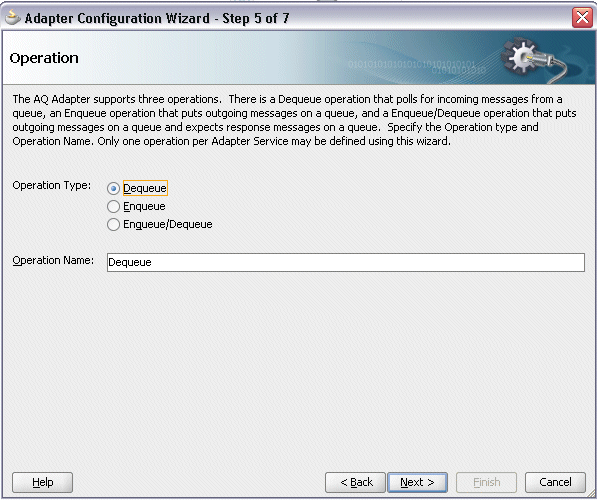
-
Click Next to open the Queue Name dialog box.
Select 'APPLSYS' as the Database Schema field. Enter 'ECX_OUTBOUND' as the Queue Name field.
Queue Name Dialog

-
Click Next to open the Queue Parameters dialog box.
Queue Parameters Dialog

Enter a unique customer name, such as 'Hilman and Associates', in the Correction Id field. Click Next. The Messages dialog box opens.
-
Click Browse for schema file to open the Type Chooser window.
Click Import Schema Files on the top right corner of the Type Chooser window. This opens the Import Schema File pop-up window.
Click the Browse Resources... icon to display the SOA Resource Browser window. Select the xsd folder as the location and
CONFIRM_BOD_004.xsdfile from the folder.SOA Resource Browser Dialog to Import a Desired Schema

Click OK. The Localize Files dialog box opens. Click OK.
Localize Files Dialog

In the Type Chooser window, the selected
CONFIRM_BOD_004.xsdfile is displayed. Scroll down to select theCONFIRM_BOD_004schema fromCONFIRM_BOD_004.xsd. Click OK.Type Chooser Dialog to Select a Desired Schema

The Messages dialog box is automatically displayed with the selected schema location and schema element.
Messages Dialog with Selected Schema

-
Click Next to proceed to the Finish dialog box to confirm that you have finished defining the AQ Adapter for the
GetAckservice. -
Click Finish. The wizard generates the WSDL file corresponding to the
GetAckservice.Click Apply and then OK to complete the partner link configuration. The partner link is created with the required WSDL settings, and is represented in the BPEL project by a new icon in the border area of the process diagram.
Adding a Receive Activity
This step is to configure a Receive activity to receive XML data from the partner link GetAck that you configured for the AQ Adapter.
The XML data received from the Receive activity is used as an input variable to the Assign activity that will be created in the next step.
To add a Receive activity:
-
In Oracle JDeveloper, expand the BPEL Constructs from the Component Palette. Drag and drop the Receive activity into the center swim lane of the process diagram.
-
Link the Receive activity to the
GetAckpartner link. The Receive activity will take event data from the partner link. The Edit Receive dialog box appears. -
Enter a name for the Receive activity.
Click the Create icon next to the Variable field to create a new variable. The Create Variable dialog box appears.
-
Select Global Variable, and then enter a name for the variable. You can accept the default name. Click OK to return to the Edit Receive dialog box.
Edit Receive Dialog
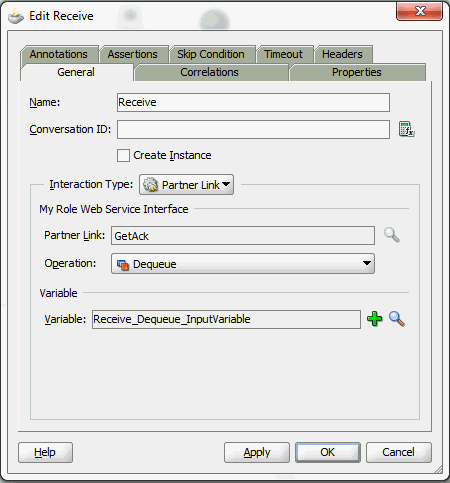
-
Click Apply and OK to finish configuring the Receive activity.
The Receive activity appears in the BPEL process diagram.
Adding a Partner Link for File Adapter
Use this step to configure a partner link by writing the purchase order acknowledgement to an XML file.
To add a Partner Link for File Adapter:
-
In Oracle JDeveloper, drag and drop the File Adapter service from the BPEL Services list into the right Partner Link swim lane of the process diagram. The Adapter Configuration wizard appears.
-
Click Next. The Service Name dialog box appears.
-
Enter a name for the File Adapter service, such as
WriteAck. -
Click Next and the Adapter Interface dialog box appears.
Select the Define from operation and schema (specified later) radio button and click Next. The Operation dialog box appears.
-
Specify the operation type, for example Write File. This automatically populates the Operation Name field.
-
Click Next to access the File Configuration dialog box.
-
For the Directory specified as field, select Logical Path. Enter directory path in the Directory for Outgoing Files field, and specify a naming convention for the output file such as
PO_%yyMMddHHmmss%.xml. -
Confirm the default write condition: Number of Messages Equals 1. Click Next. The Messages dialog box appears.
-
Select the Browse checkbox to locate the schema location and schema element.
The Type Chooser dialog box appears. Expand the Project Schema Files > CONFIRM_BOD_004.xsd and select
CONFIRM_BOD_004.Type Chooser Dialog
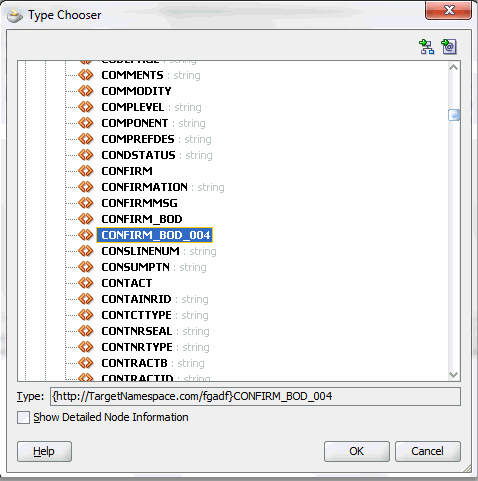
Click OK in the Type Chooser window to populate the selected schema location and element in the Messages dialog box.
Messages Dialog with Selected Schema
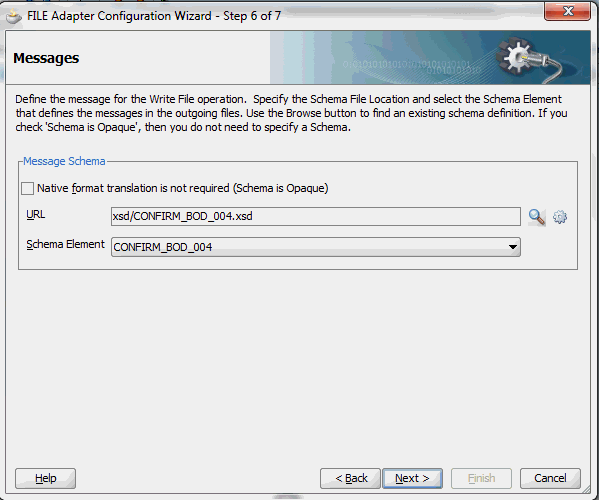
-
Click Next and then Finish. The wizard generates the WSDL file corresponding to the partner link. The main Create Partner Link dialog box appears, specifying the new WSDL file
WriteAck.wsdl.Click Apply and then OK to complete the configuration and create the partner link with the required WSDL settings for the File Adapter Service.
The
WriteAckPartner Link appears in the BPEL process diagram.
Adding an Invoke Activity
This step is to configure an Invoke activity to send the purchase order acknowledgement that is received from the Receive activity to the WriteAck partner link in an XML file.
To add an Invoke activity:
-
In Oracle JDeveloper, expand the BPEL Constructs from the Component Palette. Drag and drop the Invoke activity into the center swim lane of the process diagram, after the Receive activity.
-
Link the Invoke activity to the
WriteAckservice. The Invoke activity will send event data to the partner link. The Edit Invoke dialog box appears. -
Enter a name for the Invoke activity, and then click the Create icon next to the Input Variable field to create a new variable. The Create Variable dialog box appears.
-
Select Global Variable, and then enter a name for the variable. You can also accept the default name. Click OK.
Click Apply and then OK in the Edit Invoke dialog box to finish configuring the Invoke activity.
The Invoke activity appears in the process diagram.
Adding an Assign Activity
Use this step to pass the purchase order acknowledgement details from the Receive activity to the Invoke activity.
To add an Assign activity:
-
In Oracle JDeveloper, expand the BPEL Constructs from the Component Palette. Drag and drop the Assign activity from the Component Palette into the center swim lane of the process diagram, between the Receive activity and the Invoke activity.
-
Double-click the Assign activity to access the Edit Assign dialog box.
-
Select the Copy Rules tab and expand the source and target trees:
-
In the From navigation tree, navigate to Variables > Process > Variables > Receive_DEQUEUE_InputVariable and select CONFIRM_BOD_004. The XPath field contains your selected entry.
-
In the To navigation tree, navigate to Variables > Process > Variables > Invoke_Write_InputVariable > body and select CONFIRM_BOD_004. The XPath field contains your selected entry.
Edit Assign Dialog
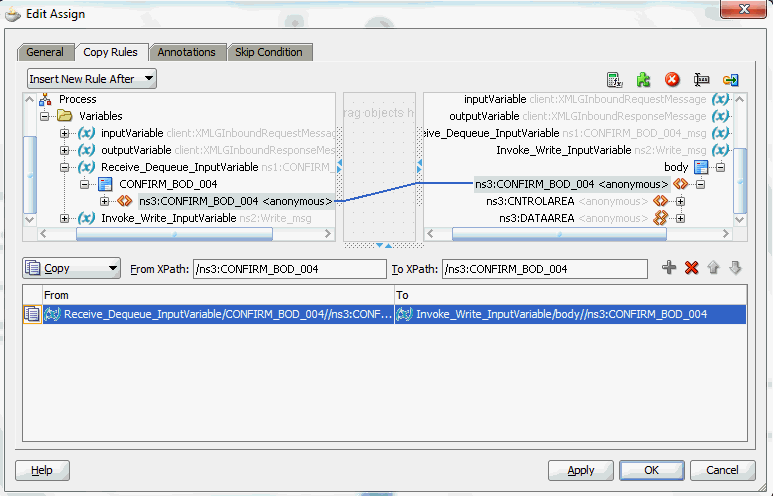
Drag the source node (CONFIRM_BOD_004) to connect to the target node (CONFIRM_BOD_004) that you just identified. This creates a line that connects the source and target nodes. The copy rule is displayed in the From and To sections at the bottom of the Edit Assign dialog box.
-
-
Click Apply and then OK in the Edit Assign dialog box to complete the configuration of the Assign activity.
Deploying and Testing the SOA Composite Application with BPEL Process at Runtime
After creating a SOA composite application with BPEL process for XML Gateway outbound message map, you need to deploy it to the Oracle WebLogic managed server. This can be achieved using Oracle JDeveloper. Once the composite is deployed, it can be tested from the Oracle Enterprise Manager Fusion Middleware Control Console.
Prerequisites
Before deploying the SOA composite with BPEL process using Oracle JDeveloper, you must have established the connectivity between the design-time environment and the runtime server. For information on how to configure the necessary server connection, see Configuring Server Connection.
Note: If a local instance of the WebLogic Server is used, start the WebLogic Server by selecting Run > Start Server Instance from Oracle JDeveloper. Once the WebLogic Admin Server "DefaultServer" instance is successfully started, the <Server started in Running mode> and DefaultServer started message in the Running:DefaultServer and Messages logs should appear.
Perform the following runtime tasks:
Deploying the SOA Composite Application with BPEL Process
You must deploy the SOA composite application with BPEL process (XMLGOutbound.bpel) that you created earlier before you can run it.
To deploy the SOA composite application BPEL process:
-
In the Applications Navigator of Oracle JDeveloper, select the XMLGOutbound project.
-
Right-click the project and select Deploy > [project name] > [serverConnection] from the menu.
For example, you can select Deploy > XMLGInbound > SOAServer to deploy the process if you have the connection appropriately.
Note: If this is the first time to set up the server connection, then the Deployment Action dialog appears. Select 'Deploy to Application Server' and click Next.
Deployment Action Dialog

In the Deploy Configuration dialog, ensure the following information is selected before clicking Next to add a new application server:
-
New Revision ID: 1.0
-
Mark composite revision as default: Select this checkbox.
-
Overwrite any existing composites with the same revision ID: Select this checkbox.
The steps to create a new Oracle WebLogic Server connection from Oracle JDeveloper are covered in Configuring Server Connection.
-
-
In the Select Server dialog, select 'soa-server1' that you have established the server connection earlier. Click Next.
-
In the SOA Servers dialog, accept the default target SOA Server ('soa-server1') selection.
Click Next and Finish.
-
If you are deploying the composite for the first time from your Oracle JDeveloper session, the Authorization Request window appears. Enter username and password information specified during Oracle SOA Suite installation. Click OK.
-
Deployment processing starts. Monitor deployment process and check for successful compilation in the SOA - Log window.
Verify that the deployment is successful in the Deployment - Log window.
Testing the SOA Composite Application with BPEL Process
Once the BPEL process contained in the SOA composite application has been successfully deployed, you can manage and monitor the process from Oracle Enterprise Manager Fusion Middleware Control Console. You can log in to Oracle E-Business Suite to manually create and book the order as well as generate the order acknowledgement by submitting a Workflow Background Process concurrent request.
Log in to the Oracle Enterprise Manager Fusion Middleware Control Console to validate the BPEL process which writes purchase order acknowledgement in an output directory after receiving from the XML Gateway ECX_OUTBOUND queue.
To manually test the SOA composite application with BPEL process:
-
Log in to Oracle E-Business Suite as a user who has the XML Gateway responsibility.
This is to ensure that the XML Gateway trading partner is set up correctly so that a purchase order can have a valid customer that has been defined.
-
Select Define Trading Partner from the navigation menu to access the Trading Partner Setup window.
-
Enter the header values on the Trading Partner Setup form as follows:
-
Trading Partner Type: Customer
-
Trading Partner Name: For example, Example Inc.
-
Trading Partner Site: Enter a trading partner site information, for example, 401 Island Parkway Redwood Shores, CA 94065.
-
Company Admin Email: Enter a valid email address.
-
-
Enter the following trading partner details:
-
Transaction Type: ECX
-
Transaction SubType: CBODO
-
Standard Code: OAG
-
External Transaction Type: BOD
-
External Transaction SubType: CONFIRM
-
Direction: Out
-
Map: ECX_CBODO_OAG72_OUT
-
Connection / Hub: DIRECT
-
Protocol Type: BPEL
-
Username: 'operations'
-
Password: Enter the associated password for the user 'operations' twice.
-
Protocol Address: 'http://us.example.com'
Protocol Address is the complete URL where the XML document can be posted.
-
Source Trading Partner Location Code: Example-01
Trading Partner Setup Form

-
-
Save the trading partner details.
To successfully generated PO Acknowledgement, perform the following setup tasks in Order Management and then manually book the order:
-
Switch responsibility back to Order Management Super User, Vision Operations (USA) and select Customer > Standard from the navigation menu to open the Enter Customer form.
-
Search on the 'Example Inc' in the Name field and click Go.
-
Select the Business World with the following information from the search results:
-
Name: Example Inc.
-
Registry ID: 1004
-
Address: 401 Island Parkway Redwood Shores, CA 94065
-
-
Select the account with the following information:
-
Account Number: 1004
-
Account Description: Example Inc.
-
Status: Active
-
-
Click the Details icon to open the Update Account: 1608 page.
-
Locate the address with 401 Island Parkway Redwood City, CA 94065 and click the Details icon to open the Site page of your selected account.
-
In the Site Details tab, the Account Site Details region, enter 'Example-01' in the EDI Location field.
-
In the Business Purposes tab, create a new row with the following values:
-
Purpose: Sold To
-
Check on the 'Primary' checkbox
Click Apply.
-
Use the following steps to generate acknowledgement for the order that you have created for the XML Gateway Inbound service.
-
Log in to Oracle E-Business Suite as a user who has the same Order Management Super User, Vision Operations (USA) responsibility. Select Order Returns > Sales Order to open the Sales Orders form.
-
Retrieve the order that you have created earlier in the XML Gateway inbound service by entering the order ID 'PO-4466-5' in the Customer PO field.
-
Click Book Order to book the order.
Notice that the Status field is now changed to 'Booked'.
Sales Orders Form

-
Switch to the System Administrator responsibility and select Request > Run.
-
Select Single Request and click OK.
-
Enter the following information in the Submit Request form:
Submit Request Form and Parameters Dialog
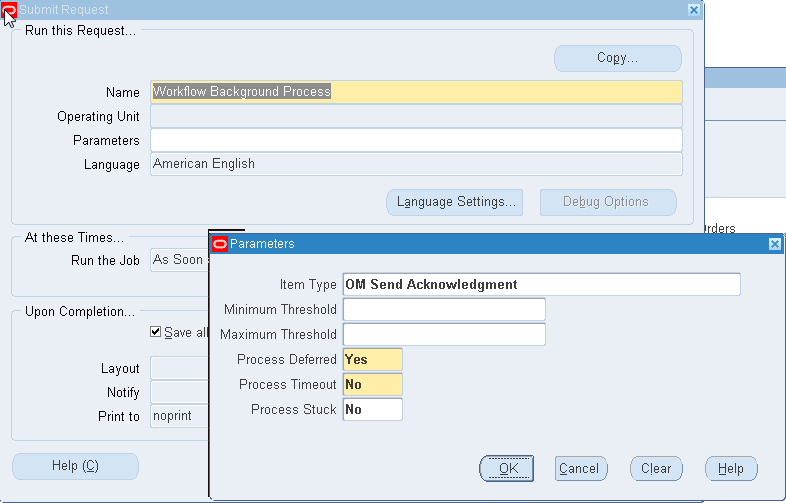
-
Name: Workflow Background Process
-
Enter the following parameters:
-
Item Type: OM Send Acknowledgement
-
Process Deferred: Yes
-
Process Timeout: No
-
Process Stuck: No
-
-
Click OK.
-
-
Click Submit to submit the 'send acknowledgement' request.
-
View your request by entering the request ID to ensure its status is 'Success'.
Validation Using Oracle Enterprise Manager Fusion Middleware Control Console
Log in to Oracle Enterprise Manager Fusion Middleware Control Console (http://<servername>:<portname>/em) to confirm that the XMLGOutbound process has been deployed. This process is continuously polling the ECX_OUTBOUND queue for purchase order acknowledgement.
From the Farm navigation pane, expand the SOA > soa-infra node in the tree to navigate through the SOA Infrastructure home page and menu to access your deployed SOA composite applications running on soa-infra managed server. Click the XMLGOutbound [1.0] link.
Click Test. The Test Web Service page for initiating an instance appears. Enter the input string required by the process and click Test Web Service to initiate the process. The test results appear in the Response tab upon completion. Click your BPEL service component instance link (such as XMLGOutbound) to display the Instances page where you can view the process details of the BPEL activities in the Audit Trail tab.
Click the Flow tab to check the BPEL process flow diagram. Click an activity of the process diagram to view the activity details and flow of the payload through the process. For example, click Receive activity. Click the view xml document link to open the received XML file. Note the Reference ID such as Customer PO.
Go to the directory you specified for the write operation, for example outputDir - logical location (typically c:\temp) where the File Adapter has placed the file after writing the PO Acknowledgement in an XML file (such as 'PO_060719175318.xml').
Open the 'PO_060719175318.xml' file and search for ORIGREF element. Its value should be 'PO-4466-5' (the order booked) for which the acknowledgement is generated.